Effective Methods for Managing Red Squirrels
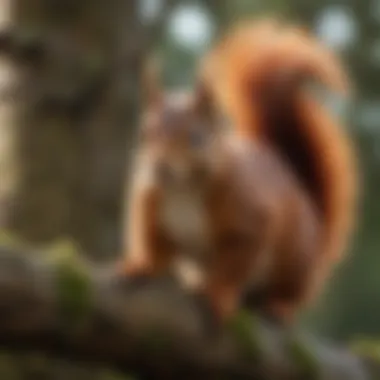
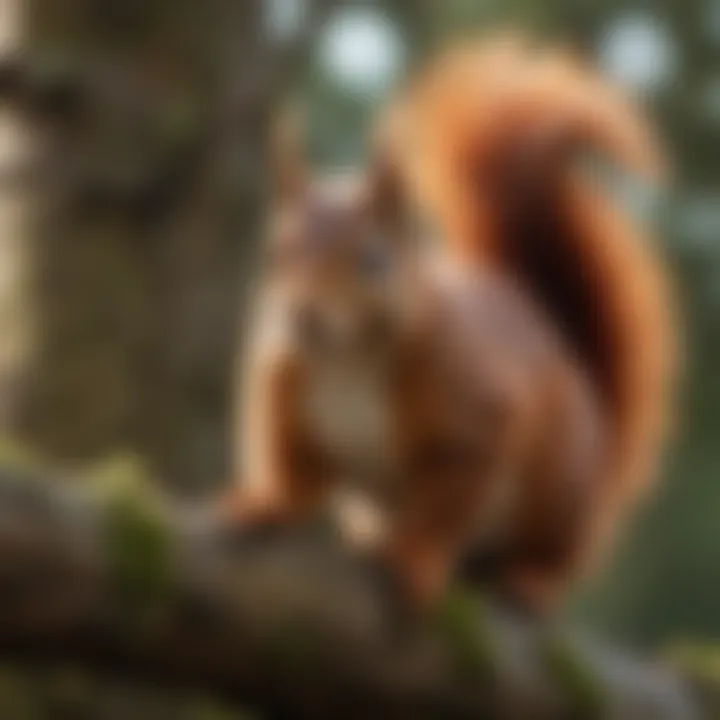
Intro
Managing red squirrel populations effectively is increasingly relevant for many homeowners and nature enthusiasts. These small mammals, while adorable and often admired, can also pose challenges when they invade residential spaces. The need for a balance between appreciating wildlife and maintaining comfort in our homes cannot be overstated. This guide seeks to provide a comprehensive overview of strategies that enable individuals to manage the presence of red squirrels in a humane and sustainable way.
The article will highlight specific behaviors of red squirrels, explore humane exclusion methods, and demonstrate the importance of careful habitat management. Ultimately, it presents a balanced approach to coexistence between human environments and squirrel populations, equipping the reader with practical solutions tailored to their needs.
Understanding these facets can help mitigate the challenges red squirrels pose, ensuring that both our living spaces and the local ecosystem remain healthy.
Design Inspiration
While not typically associated with design, applying concepts from wildlife management to our environments can inspire beautifully integrated outdoor areas. The notion of design extends beyond aesthetics; it includes strategic planning for habitats.
Trending Styles
Incorporating natural elements such as trees, shrubs, and native plants not only enhances the landscape but also creates a habitat that may deter invasive squirrel populations.
Utilizing native plants is essential as they attract local fauna without enabling a dominance of species like the invasive grey squirrel. When designing, consider:
- Natural wood accents: Use untreated wood for structures like birdhouses or fences, maintaining the aesthetic appeal of natural materials.
- Incorporation of greenery: Create zones with dense foliage, which might help form boundaries that red squirrels prefer to navigate around rather than invade.
Color Palettes
Natural earthy tones should guide your color selections to align with the goal of harmonious outdoor spaces. Think:
- Soft greens and browns
- Warm neutral shades
- Accents of vibrant falls hues to reflect the scenery in seasons.
These colors not only represent the natural environment but also create an inviting atmosphere for homeowners and visitors alike.
Practical Tips
Effectively managing red squirrel populations requires pragmatism and foresight. Here, we break down practical tips into clear strategies.
Maintenance & Care
Regular maintenance of your outdoor areas can significantly influence the presence of red squirrels. Embrace measures that can help make your space less hospitable:
- Maintain bird feeders: Regularly clean and empty to reduce squirrel attraction.
- Seal entry points: Check for gaps in roofs or walls that might allow access.
- Store food securely: Ensure that pet food and bird seed are stored in airtight containers and removed when not in use.
Budgeting & Planning
Consider the financial aspects when implementing wildlife management strategies. Investing in durable materials for maintenance can save money in the long run by reducing damage caused by squirrels. Here are a few budgeting tips:
- Prioritize: Identify areas in your property that need immediate attention.
- Research: Look into local suppliers for relevant materials at competitive prices.
- DIY Solutions: Many exclusion methods can be implemented with minimal tools and materials, which further cuts costs.
By understanding and applying these effective methods, homeowners can manage red squirrel populations while fostering environments that appreciate the beauty and intricacies of local wildlife.
Understanding Red Squirrels
Understanding red squirrels is the foundational step for anyone aiming to manage their populations effectively. It is essential to grasp their biological and behavioral traits, which can facilitate better strategies for coexistence. This section aims to illuminate key aspects of red squirrels that homeowners and enthusiasts should be aware of, shedding light on critical elements such as their physical characteristics, behavioral traits, and habitats.
Physical Characteristics
Red squirrels, known scientifically as Sciurus vulgaris, are distinct in appearance. They typically have a bushy tail that serves multiple purposes, including balance during agile movements and warmth in colder climates. Their fur is a striking reddish-brown, although variations may appear based on region and season. During winter, their fur can adopt a more greyish hue for camouflage in snowy environments.
Another notable feature is their size. Adult red squirrels generally weigh between 0.5 to 1.5 pounds. They measure about 9 to 12 inches in body length, not accounting for their tails, which can be as long as their body. Distinguishing red squirrels from other species, such as the grey squirrel, is crucial for effective management.
Behavioral Traits
Red squirrels exhibit a variety of behaviors that impact their interactions with human environments. These squirrels are primarily diurnal, meaning they are most active during the day. They are agile climbers, often seen bounding through trees in search for food. Their diet mainly includes seeds, nuts, and fruits, making gardens and bird feeders a prime target for foraging.
Socially, red squirrels tend to be more solitary compared to their grey counterparts. They establish territories, which they actively defend against intruders. Recognizing these territorial behaviors can help homeowners devise exclusion strategies and humane deterrents.
Habitat and Range
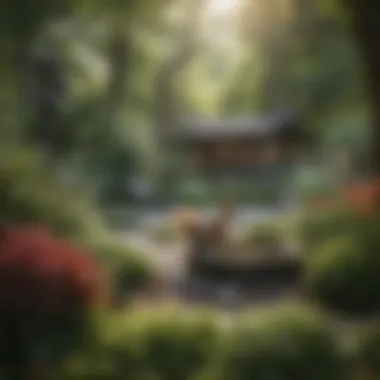

The natural habitat of red squirrels typically includes coniferous and mixed forests, where they find ample food sources and nesting sites. They make nests, often called dreys, in tree branches or hollows. Their range spans across much of North America, Europe, and parts of Asia, making them a prevalent species in various regions.
In residential areas, red squirrels can adapt surprisingly well. They can thrive in parks, gardens, and even urban environments where trees are available. This adaptability makes understanding their habitat needs critical for effective population management.
"Understanding the ecology and habits of red squirrels is vital for anyone who wishes to manage their impact on gardens and public spaces."
Acquiring knowledge about red squirrels enables homeowners to implement effective management techniques. By addressing their characteristics, behaviors, and habitats, we can foster a more harmonious relationship with these creatures in our environments.
The Impact of Red Squirrels
Understanding the impact of red squirrels is crucial for homeowners and gardening enthusiasts alike. These creatures, while often seen as charming and vibrant additions to the landscape, can pose significant challenges. Their behavior and habits influence both garden aesthetics and the broader environment. Clearly identifying how red squirrels affect gardens and residential areas enables effective management strategies.
Effects on Gardens
Red squirrels have distinct feeding habits that can lead to notable damage in gardens. One primary concern is their penchant for raiding bird feeders. They frequently consume seeds, peanuts, and other offerings meant for birds, which can discourage avian visitors from returning. In addition, red squirrels may be drawn to fruits and nuts. They will raid fruit trees and shrubs, consuming ripening fruit and causing concern for gardeners.
Damage can often extend beyond mere consumption. Red squirrels may also strip bark off young trees, leading to long-term harm. Such actions hinder growth and diminish the overall health of trees in your landscape.
"The presence of red squirrels in garden spaces may seem innocuous, yet their feeding behaviors can lead to unexpected consequences for gardening enthusiasts."
To mitigate these effects, homeowners might consider implementing barriers around vulnerable plants, using squirrel-proof feeders, or placing decoys of predator animals in their gardens. Red squirrels are perceptive; they often avoid areas where they sense danger. This proactive approach can help protect plants while still fostering the local wildlife ecosystem.
Challenges for Homeowners
Homeowners frequently encounter challenges as red squirrel populations increase. Their exploratory nature leads to nesting in attics or other parts of a house, creating headaches for residents. Once settled, they are determined and can cause damage to insulation, wiring, and wooden structures. This likelihood of structural damage results in costly repairs.
Another challenge arises from their territorial behaviors. They can be aggressive if they feel their territory is encroached upon, leading to conflicts with pets or other wildlife. Their presence can increase the stress of managing a property and require homeowners to take additional steps—like securing trash and monitoring structures for entry points.
Finally, red squirrels can shift the balance of local wildlife populations. Their feeding habits can affect the availability of resources for other species, leading to changes in biodiversity. Managing this impact requires a comprehensive understanding of their behavior and ecological role.
Taking a multifaceted approach to managing the issues presented by red squirrels not only protects one's home but also fosters a more harmonious relationship with nature. Homeowners must be proactive, observing how these squirrels interact with their landscape and adapting their strategies in response.
Humane Deterrent Techniques
Managing red squirrels humanely is essential not only for the squirrels themselves but also for homeowners who wish to coexist peacefully with wildlife. Humane deterrent techniques focus on preventing squirrel access to areas where they might cause damage or disruption. These methods prioritize animal welfare while effectively reducing the possibility of conflict. By understanding and implementing these techniques, homeowners can minimize the likelihood of red squirrels becoming a nuisance.
Exclusion Measures
Exclusion measures are proactive steps taken to prevent red squirrels from entering specific areas. This approach is critical because it addresses the root cause of the problem by sealing off potential entry points before control measures become necessary.
Sealing Entry Points
Sealing entry points is a fundamental aspect of exclusion. This method involves checking and repairing holes or gaps in buildings, particularly in attics or basements where squirrels often seek shelter. A key characteristic of this approach is its effectiveness. By blocking access points, homeowners can significantly reduce the chance of squirrels entering and nesting.
The unique feature of sealing entry points is that it not only deters red squirrels but also excludes other pests. This provides a multi-faceted benefit, contributing to a more stable and healthy living environment. However, one must be cautious; improper sealing can lead to trapped animals, which may generate additional issues. Therefore, it’s critical to ensure all entry points are clearly identified and properly closed. This option remains a popular choice in home management due to its straightforward application and effectiveness.
Using Fencing and Barriers
Using fencing and barriers effectively creates physical obstacles to deter red squirrels from gardens and yards. This approach is especially useful in areas with gardens that may attract squirrels seeking food. The key characteristic of this method lies in its versatility. Fencing options can include mesh, wood, or metal barriers, depending on the specific needs of the property.
The unique feature of using these barriers is the ability to customize them according to the landscape and squirrel behavior. For instance, garden fences can be designed to extend below ground level, preventing tunneling. This method is advantageous because it directly protects plants and vegetables from being raided. On the downside, installing barriers requires significant effort and careful planning to ensure their effectiveness, as squirrels can still climb if the fence is not high enough or lacking an overhang.
Natural Deterrents
Natural deterrents leverage the natural instincts of red squirrels to discourage them from invading specific areas. These methods often involve using scents or introducing certain elements into the environment that make it less appealing for the wildlife.
Scents and Predators
Utilizing scents and the presence of predator indicators serves as a natural deterrent. Red squirrels are instinctively wary of predators, and certain scents can trigger this behavior. For example, using coyote urine or predator feces near entry points can signal danger, encouraging squirrels to seek safety elsewhere.
This method is beneficial because it relies on the squirrels’ natural instincts without causing them harm. However, care should be taken to ensure that the products used are safe for other wildlife and pets. This option is popular due to its low environmental impact and ease of use. It does not require significant human intervention, making it appropriate for many homeowners.
Plant Selection
Plant selection plays a crucial role in shaping an environment less appealing to squirrels. Certain plants can deter red squirrels while still allowing homeowners to cultivate appealing landscapes. Choosing plants that squirrels typically avoid, such as specific herbs or aromatic flowers, can reduce their presence.
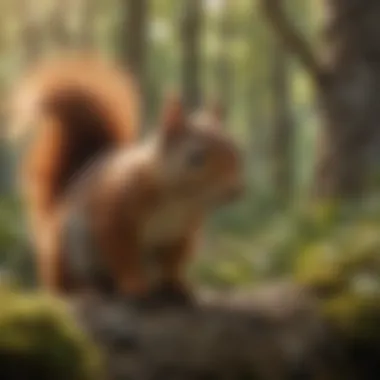
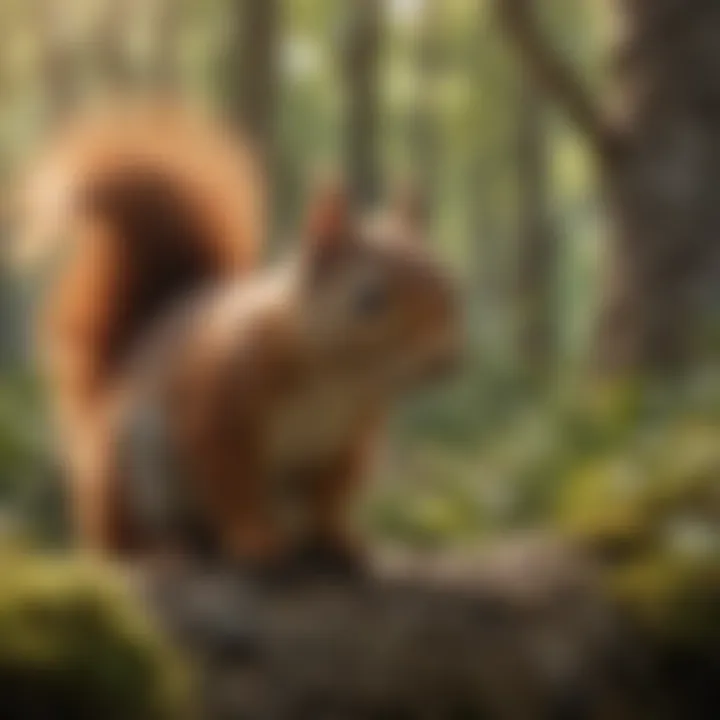
The key characteristic of this aspect is the dual benefit of beautifying one's property while discouraging unwanted wildlife. The unique feature of plant selection is its sustainability; it encourages a natural balance in the garden ecosystem. However, one potential downside is that it may not eliminate squirrel presence entirely, especially in areas where food resources are scarce. Nevertheless, it remains an effective method within a comprehensive management plan.
Habitat Management Strategies
Effective habitat management is a critical component when dealing with red squirrel populations. It involves adjusting and modifying the environment to create a balanced ecosystem that minimizes conflict between these animals and human habitats. By focusing on landscape modification and barrier creation, homeowners can significantly reduce encounters with red squirrels. Additionally, good habitat management strategies can lead to healthier tree populations and improved overall yard conditions, which benefits both wildlife and residential aesthetics.
Modification of Landscape
Tree Management
Tree management is an essential aspect of modifying the landscape to manage red squirrels. The strategy involves assessing tree health and selecting appropriate species for planting. Maintaining tree canopies can limit access points for red squirrels, reducing their nesting opportunities. A key characteristic of effective tree management is pruning. Pruning trees can not only help in maintaining their health but also create a less favorable environment for nesting.
One advantage of this approach is that it promotes more robust tree growth, which ultimately enhances the aesthetics of your yard. However, it requires knowledge of local tree species and their growth patterns, which can be a disadvantage for homeowners unfamiliar with horticulture.
Yard Maintenance
Yard maintenance complements tree management by ensuring the surroundings of your home remain less appealing to red squirrels. Regular upkeep includes mowing, removing debris, and managing plant growth. This practice can prevent squirrels from finding potential nesting areas near your home. The key characteristic of yard maintenance lies in its proactive nature. Keeping the yard clean minimizes hiding spots and nesting sites.
A unique feature of well-maintained yards is that they not only deter pests but also enhance the overall beauty of your landscape. However, it might require consistent effort and investment in gardening tools, which some homeowners may find burdensome over time.
Creating Barriers
Mulching and Ground Covers
Mulching and ground covers serve as practical ways to manage red squirrels effectively. Covering the soil with mulch reduces exposed ground, making it harder for squirrels to dig. It can also deter them from foraging. The key characteristic of this strategy is its versatility. Mulching can be applied not only for pest management but also for moisture retention and soil health.
One advantage is that it supports plant growth while minimizing potential red squirrels’ activities. On the other hand, homeowners must be aware that not all types of mulch are equally effective, and some can attract other pests, which can be seen as a disadvantage.
Adjusting Food Sources
Adjusting food sources involves managing what is available for red squirrels in your yard. This can include limiting bird feeders or placing them strategically. The key characteristic of adjusting food sources is the awareness of what attracts these animals. By making specific changes, homeowners can reduce interactions with squirrels.
The unique feature of this approach is its direct impact on reducing a squirrel's food supply, pushing them to find alternatives elsewhere. However, a disadvantage is that this can also affect other wildlife that may rely on the same food sources, possibly leading to an imbalance in the local ecosystem.
"Managing red squirrel populations through habitat strategies requires understanding their behaviors and what makes them thrive in certain environments."
Snap Traps and Live Traps
Managing red squirrels may sometimes require more direct methods, particularly when traditional deterrents are ineffective. Using traps is a common practice among homeowners dealing with squirrel populations. Snap traps and live traps present two distinct options, each with its own set of benefits and considerations. Choosing the right method can greatly influence the outcome of your efforts in managing these furry creatures.
Choosing Traps Wisely
When selecting traps for red squirrels, it is crucial to consider various factors to ensure effectiveness and compliance with local laws. Snap traps are designed to kill the animal quickly and are typically less expensive and easier to find in stores. These traps rely on a spring-loaded mechanism to deliver a rapid strike, minimizing suffering. However, homeowners must be cautious about where and how these traps are set, as they can inadvertently injure non-target species.
On the other hand, live traps offer a humane option, allowing for the capture of red squirrels without causing harm. Once captured, these squirrels can be relocated according to local wildlife regulations. Live traps must be checked frequently, as trapped animals can experience stress if left for prolonged periods. Homeowners should also ensure these traps are large enough to accommodate adult squirrels comfortably.
In summary, the choice between snap traps and live traps often depends on personal preference concerning humaneness, cost, and the need for compliance with wildlife management rules.
Placement Techniques
Successful trapping hinges on strategic placement. For snap traps, position them along established squirrel pathways, which are often identified by frequent signs of activity, such as gnawed nuts or footprints. Setting traps near nesting sites can also increase capture rates, as squirrels are more likely to traverse these areas.
When using live traps, it's advisable to place them near food sources. Bait such as peanut butter or sunflower seeds can attract squirrels. Position traps at ground level and conceal them with natural vegetation to improve visibility and decrease the chances of non-target species entering.
For both types of traps, it's important to check them daily. This ensures that any caught animals, particularly in live traps, do not experience undue stress. Following best practices in trap placement not only increases capture success but also reflects responsible wildlife management.
"Trapping should be undertaken with the utmost regard for animal welfare and local regulations."
Knowing the ins and outs of snap traps and live traps can facilitate effective management of red squirrel populations, helping homeowners reclaim their space in a humane and legal manner.
Professional Intervention
Professional intervention can make a significant difference in managing red squirrels effectively. While many homeowners may attempt DIY methods, certain situations require the expertise of trained professionals. Red squirrels, though often seen as friendly creatures, can become problematic if their population grows unchecked. Knowing when to seek help from a professional is crucial for an effective management approach.
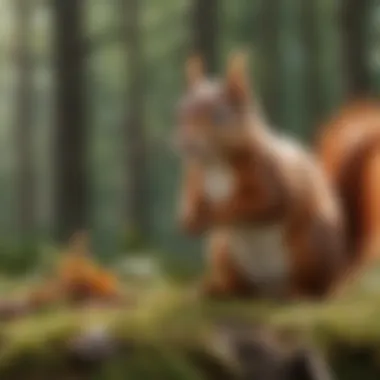
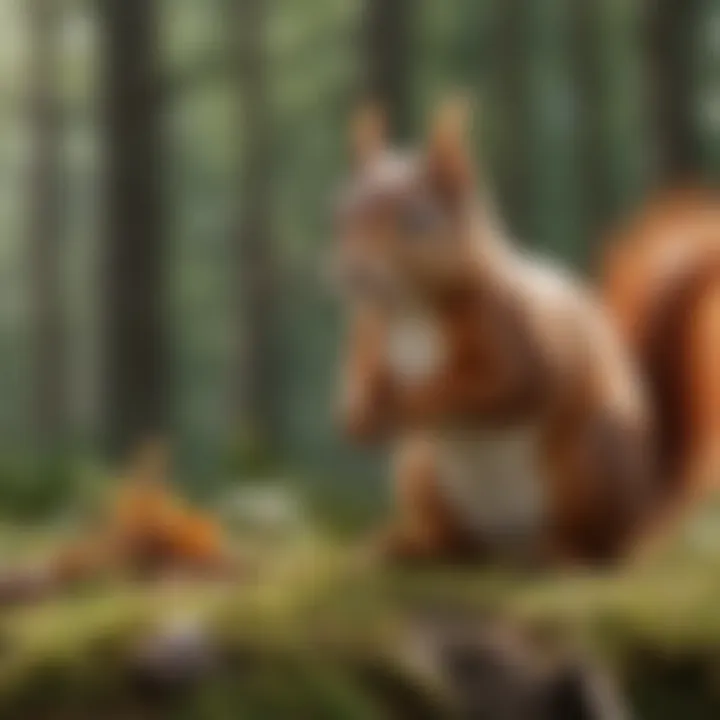
When to Seek Help
There are specific circumstances that indicate the necessity for professional intervention in red squirrel management:
- Signs of Infestation: If you observe frequent sightings of red squirrels in your attic, walls, or other enclosed spaces, this may be a sign of nesting.
- Damage to Property: Red squirrels can cause extensive damage by gnawing on wires, wood, insulation, and other materials. If damage becomes noticeable, it may be time to consider professional help.
- Health Risks: Red squirrels can carry parasites and diseases. If you suspect that their presence may pose health risks to your family or pets, it is prudent to call in experts.
- Ineffective DIY Methods: If personal efforts to deter or remove squirrels prove unsuccessful over an extended period, re-evaluating the strategy with professional help may be necessary.
Seeking help early can prevent issues from escalating, preserving both your property and your peace of mind.
Understanding Wildlife Removal Services
Wildlife removal services specialize in humane and effective management of animal populations. They offer several advantages that every homeowner should consider:
- Expertise and Experience: Professionals are trained to identify squirrel behavior and understand the best approaches. They can effectively evaluate the severity of the problem and tailor their methods accordingly.
- Humane Solutions: Many wildlife removal services prioritize humane practices. They understand local laws and regulations regarding animal treatment, which is beneficial for ethical considerations.
- Preventive Measures: After removal, professionals do not just leave homeowners to fend for themselves. They often provide extensive guidance on preventive measures, helping to secure the property against future infestations. This may include sealing entry points or changing landscaping practices to deter squirrels.
In summary, professional intervention is a valuable resource for homeowners dealing with red squirrels. Recognizing the signs and knowing when to seek help can lead to more effective outcomes. Engaging with wildlife experts not only helps in managing current situations but also institutes preventive measures for the future.
Legal Considerations
The management of red squirrel populations involves various complexities not just from ecological and behavioral perspectives but also from legal frameworks. Understanding the legal considerations is essential to ensure that management efforts are compliant with local laws and sensitive to conservation principles. This section highlights the significance of legal frameworks in wildlife management, alongside considerations that homeowners should keep in mind when addressing red squirrel issues.
Local Laws and Regulations
Homeowners often overlook legal regulations concerning wildlife, which could result in unintended violations. Local laws on wildlife management can vary significantly across regions. Hence, it is critical to familiarize yourself with the specific regulations applicable to your locality regarding red squirrels.
- Protected Species: In some areas, red squirrels may be protected under wildlife conservation laws. This can limit methods of control or management. It is pertinent to ensure that any approach undertaken is compliant with these regulations.
- Trapping and Relocation: Many regions have strict rules governing trapping and relocation of squirrels. Takes measures that might seem humane, such as relocation, could potentially violate local statutes. Be sure to check the guidelines provided by local wildlife authorities.
- Permit Requirements: In certain jurisdictions, permits may be required for any form of wildlife management, even if it is non-lethal. Ensuring you have the correct documentation can prevent legal penalties.
These points underscore the importance of conducting thorough research and consulting with local wildlife agencies or legal professionals before embarking on any management strategy concerning red squirrels.
Ethical Wildlife Management
Beyond legal considerations, ethical wildlife management plays a crucial role in how humans interact with red squirrel populations. Engaging in ethical practices promotes a balanced ecosystem and reflects a commitment to conservation principles. Here are several aspects of ethical wildlife management:
- Humane Treatment: Ensure all methods used are humane. This includes employing effective yet non-lethal deterrents and practices. Avoid cruel traps or practices that could inflict unnecessary suffering on the animals.
- Biodiversity Preservation: Red squirrels are part of the ecological fabric. Managing their populations should focus on preserving biodiversity. Ensuring their coexistence in urban and suburban areas can benefit other species as well.
- Community Education: Engaging the community in discussions about wildlife can foster understanding and support for conscientious practices. Educating others about vulnerabilities and the importance of red squirrels strengthens community ties and encourages thoughtful consideration of wildlife management.
In sum, integrating legal and ethical frameworks is paramount for achieving sustainable management practices. This not only alleviates immediate concerns but also cultivates long-term ecological harmony and responsible stewardship among homeowners.
Preventive Practices
Preventive practices are essential in managing red squirrel populations effectively. These strategies not only mitigate immediate issues but also create a long-term solution for maintaining a harmonious environment. By understanding the behavior and needs of red squirrels, homeowners can implement specific measures that minimize potential conflicts. The benefits of preventive practices may include reduced damage to gardens, less disturbance around properties, and an overall balance in the local ecosystem.
Long-Term Strategies
Long-term strategies aim to alter the environment in a way that discourages red squirrels from becoming a problem. This involves understanding their feeding habits and nesting preferences. Here are some considerations for long-term strategies:
- Selective Planting: Homeowners should choose plants that are less attractive to red squirrels. Certain flowers and shrubs can provide aesthetic value without inviting unwanted visitors.
- Feeding Practices: If residents provide food sources for birds or other wildlife, it is wise to use squirrel-proof feeders. These feeders are designed to allow access only for the intended birds.
- Continuous Monitoring: Regularly observing local wildlife can help identify when red squirrels are present and assess their behavior patterns. Adjusting practices based on these observations is vital.
Implementing these strategies not only decreases the likelihood of issues but also fosters a more sustainable approach to wildlife management.
Educating Community Members
Educating community members is a crucial aspect of preventive practices. Raising awareness around red squirrel behavior and management techniques builds a foundation for cooperative action. Here are some important aspects of educating the community:
- Workshops and Information Sessions: Local governments or wildlife organizations can host workshops to inform residents about red squirrels. These sessions can cover humane management methods and the ecological role of squirrels.
- Informational Materials: Distributing pamphlets or creating easy-to-read online resources can improve awareness. These materials can include tips on landscape management and behavioral insights of red squirrels.
- Community Initiatives: Encourage neighborhood teams to collaborate on projects. These could be clean-up days, habitat enhancements, or shared resources for squirrel management efforts.
Education leads to community-wide changes that benefit both homeowners and wildlife.
The End
Managing red squirrels effectively is vital for harmonious cohabitation between humans and wildlife. This article emphasizes various strategies that address concerns while respecting the ecological balance. Understanding red squirrels' behavior and their role in the environment allows homeowners to take informed actions.
Recap of Effective Ways
The solutions presented include humane deterrent techniques, habitat management strategies, and professional intervention when necessary. Key methods discussed are:
- Exclusion Measures: Sealing entry points and utilizing barriers prevent access to homes and gardens.
- Natural Deterrents: Introducing scents or predator figures can deter squirrels.
- Habitat Modification: Adjusting yard layouts and food sources discourages squirrels from settling in undesirable areas.
Incorporating these practices not only helps in reducing the squirrel population but also enhances the overall aesthetics and functionality of gardens and yards.
The Importance of Coexisting
Maintaining an ecological balance is crucial. While red squirrels can pose challenges, they also contribute to forest health through seed dispersion and other natural activities. Finding a middle ground ensures red squirrels are managed humanely without disrupting their role in nature. This approach nurtures an understanding of wildlife behavior, leading to more effective long-term coexistence strategies.















